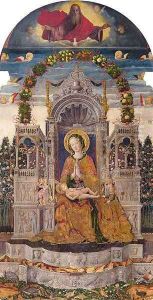Antonio da Negroponte Paintings
Antonio da Negroponte was an Italian painter of the Renaissance period, active mainly in the Republic of Venice in the mid-15th century. While the exact dates of his birth and death are not recorded, his art provides some clues to his working period. Scholars often rely on stylistic analysis and historical context to approximate the timeline of such artists, and in the case of Negroponte, he is believed to have been most active around the 1450s.
Negroponte's biography is scarce, and much of what is known about him comes from his surviving works and the mentions of his name in various documents of that era. He is most famous for the 'Madonna with Child Enthroned', which is located in the church of San Francesco della Vigna in Venice. This work is significant for its rich color and the use of gold leaf, common in Venetian painting of the time. It demonstrates the influence of Byzantine art, which was pervasive in Venetian painting due to Venice's commercial and cultural links with the Byzantine Empire.
Negroponte's style is considered to be a blend of the Byzantine tradition and the emerging Renaissance sensibilities, with an emphasis on clarity, form, and perspective that were becoming more prevalent in the art of his time. However, he never fully abandoned the gold backgrounds and iconic features of Byzantine art, instead integrating these elements into the more naturalistic style of the Renaissance.
Despite the paucity of biographical information, Antonio da Negroponte is recognized as part of the early Renaissance movement in Venice, contributing to the transition from medieval to Renaissance styles. His work continues to be appreciated for its historical value and its role in the evolution of Venetian painting.
